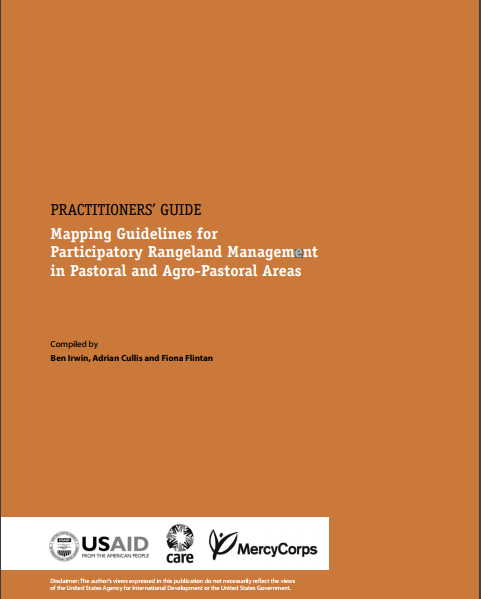Mercy Corps is a leading global organisation powered by the belief that a better world is possible. In disaster, in hardship, in more than 40 countries around the world, we partner to put bold solutions into action—helping people triumph over adversity and build stronger communities from within. Now, and for the future.
Members:
Resources
Displaying 1 - 5 of 5PRACTITIONERS’ GUIDE Mapping Guidelines for Participatory Rangeland Management in Pastoral and Agro-Pastoral Areas
This Practitioners’ Guide provides the step-by-step instructions and checklists that will guide a mapping team through a mapping exercise.
Visibility Verus Vulnerability: understanding instability and opportunity in Myanmar
Change is taking place in Myanmar. Since this ethnically and geographically diverse country elected its first civilian government in 2010, a series of rapid and dramatic reforms have taken place to allow freedom of expression, an opening of the economy and the consolidation of peace. The government has also taken the first tentative steps toward decentralization. In October 2013, Mercy Corps conducted a combined economic, governance and conflict assessment that focused on Myanmar’s southern Shan State as a microcosm of the issues present throughout the country.
Agrarian Transitions in Two Agroecosystems of Kayah State, Myanmar
... Located on Myanmar’s eastern border with Thailand, Kayah State has long been isolated because of conflicts between the minority groups there and the Burmese army; as a result, little is known about its agricultural systems. As a preliminary to NGO agricultural development projects, an agrarian diagnosis of two major types of agroecosystems in the state—lowlands alluvial plains and uplands—was conducted. The objective was to identify recent agrarian changes leading to the current presence of different types of farmers in each area and understand their development potential.
Réhabilitation d’infrastructures publiques à travers l’activation à Bel Air d’un Centre de Services à l’Entrep
General
The project aims at supporting existing actions towards the reduction of community- based violence by facilitating the employability of youth through the reinforcement of their capacities and the creation of micro and small enterprises in the construction sector in the target neighbourhoods. The selected areas of intervention are among the most vulnerable of Port-au-Prince and are characterised by high social conflict and economic insecurity which result in urban violence and unstable life conditions. ILO's efforts towards the creation of sustainable and decent jobs through professional training (aimed at obtaining State certification), production and rehabilitation of public infrastructures hope to decrease the risk of community-based violence, in agreement with the mandate of the CVR-MINUSTAH. In particular, ILO's intervention targets the young unemployed and aims to involve them in income-generating activities that will contribute to the economic development of their own neighbourhoods. Direct beneficiaries: 57 direct beneficiaries (30% women) aged between 15 and 35, including 8 entrepreneurs considered as "vulnerable", identified through a community participatory process. Indirect beneficiaries: - Families of the direct beneficiaries; - Residents and entrepreneurs of Fort National; - Old people, disabled people, children and all residents who will benefit from the pedestrian accesses built in their neighbourhood.
Unraveling complexity: Understanding the land-water-food nexus in Elgeyo-Marakwet, north-west Kenya
General
The communities of Elgeyo-Marakwet, northwest Kenya reside across the ecological continuum of the temperate Cherangany Hills and arid Kerio Valley. Heavily reliant on the land-water-food nexus, they offer a well-studied example of resilience in the face of multiple environmental changes over the last 200 years (Davies and Moore 2016). Earlier research by the PI, CoI and team has focused on management of water through a network of built water channels used for agricultural and domestic purposes; the sophisticated management of agricultural soils through complex patterns of tenure and fallowing; management of botanic resources including diverse indigenous and imported crops; and the importance of forests which serve hydraulic functions and as reserves of gathered medicines and foodstuffs. However, recent work indicates growing apprehension of the impact of new ecological changes, including general concerns over climate change, as well as a shift towards water-intensive mono-cropping, the introduction of new crops, and the installation of piped-irrigation which is exacerbating unequal access to water resources. While these latter changes were meant to help mitigate food insecurity, research suggest that they may have had the opposite effect by increasing soil degradation, introducing unfamiliar weeds and crop diseases, and placing pressure on existing water sources. Related to this are concerns about the loss of traditional natural resource management, the loss of culturally valuable biodiversity, and the implications for food security. Compounding these tensions are land-use changes within the Cherangany Forest catchment, especially deforestation resulting from increased agricultural and pastoral activities. This has raised concerns of fertilizer runoff, land degradation, biodiversity loss, and decreased water quality and quantity across the upland-valley ecological continuum. There is pressing interest among local communities and the County government, to understand the implications of these new challenges and develop practical solutions. We focus on disentangling the complex and interdependent land-water-food nexus across the Cherangany Forest reserve and the semi-arid Kerio Valley. Using ethnography, interviews, botanic survey, aerial photography, GIS mapping and building on existing collaborative strengths, we will effect these aims along two axes: 1. Forest Management and 2. Agriculture. We will collate, review and extend existing data to understand the land-water-food nexus in relation to both historic and potential future environmental changes. We will also examine existing literature on regional climatic change and collate local weather station data to produce a practical understanding of how these key axes (forests and agriculture) have and may respond to climatic fluctuation. Production of more highly resolved analyses of potential climate induced impacts seems especially important since current predictions for Eastern Africa are spatially heterogeneous and often of low certainty. To produce localized and grounded knowledge for practical policy making we will partner with Elgeyo-Marakwet County Council, nearby Eldoret University (UOE), the Marakwet Research Station (MRS), British Institute in Eastern Africa (BIEA), National Museums of Kenya (NMK) and Kenya Forestry Service (KFS) to produce research to be directly incorporated into new county-level environmental and conservation planning. We have undertaken preliminary meetings with County officials and established MOU's with UOE and MRS. This work will advance longer-term goals of developing local research capacity, encouraging appropriate resource management, and devising policy frameworks that track and address emerging climate change and other ecological impacts by bringing together experts, civil society, and policy makers. Davies, M.I.J and Moore, H.L. 2016. Landscape, time and cultural resilience. Journal of Eastern African Studies 10:67-87
Objectives
The Global Challenges Research Fund (GCRF) supports cutting-edge research to address challenges faced by developing countries. The fund addresses the UN sustainable development goals. It aims to maximise the impact of research and innovation to improve lives and opportunity in the developing world.





